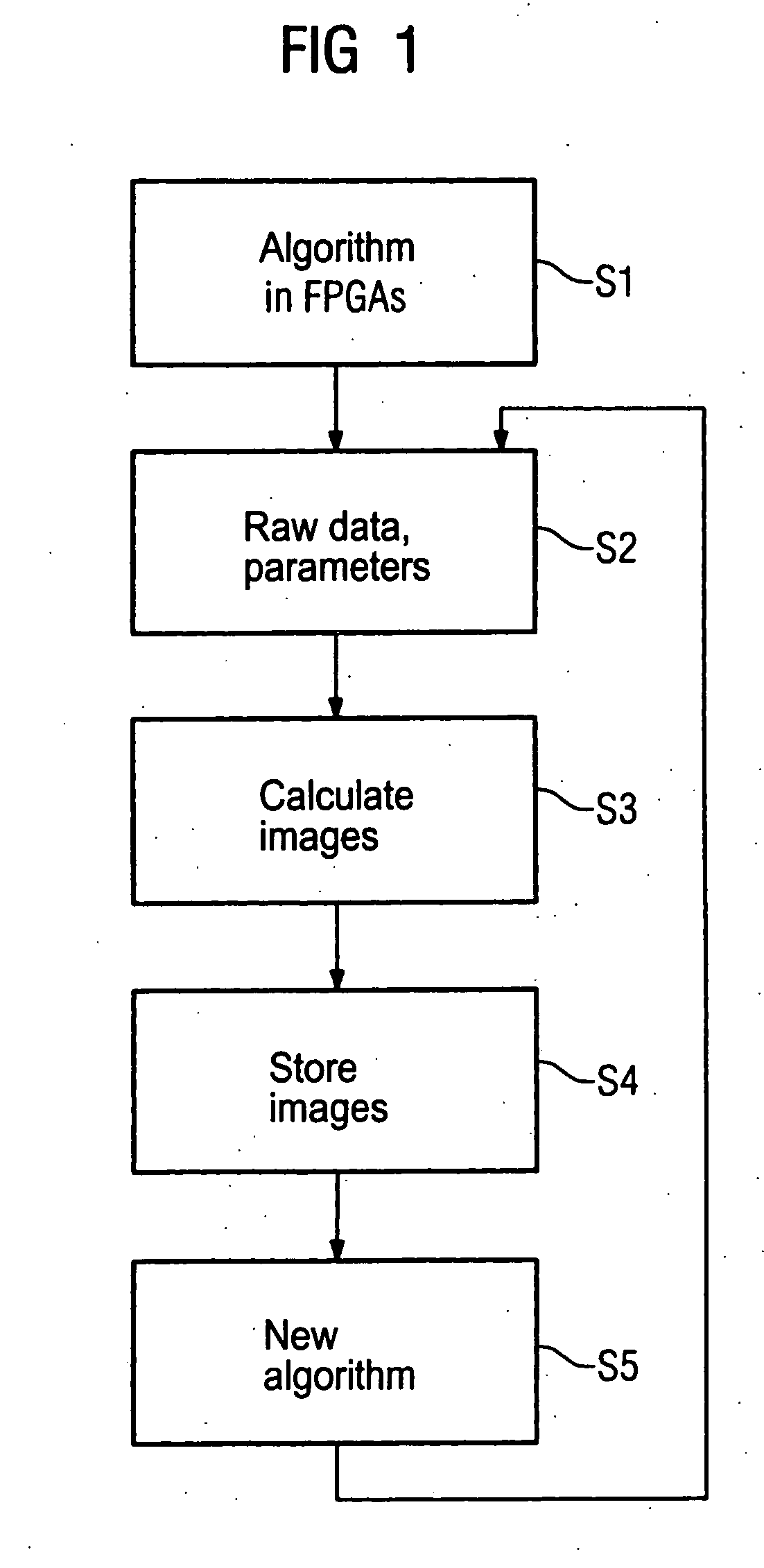[0007] An object of the present invention is to provide a method for image reconstruction as well as an
associated image processing device with which an increase of the computing capacity and an optimized
resource utilization are possible.
[0017] In the inventive method, the reprogrammable FPGA (in which, for example, the algorithm to be used is loaded at the start of an acquisition sequence) can thus completely utilize its respective available resources for the calculation. If another algorithm is necessary for a subsequent examination or, respectively, image reconstruction, this can be calculated after a suitable
reprogramming of the FPGA or FPGAs, for example given a
system restart. The image computer
system (as is present, for example, in a clinic) functions with fewer processors overall, so costs can be saved. Moreover, the images are available faster for post-processing or
medical assessment. This acceleration of the image reconstruction can also be meaningful when it must be decided as quickly as possible during an examination whether a further, possibly more precise, examination or an examination concerning a different
body region must be conducted. In this case, the patient does not have to wait long until the reconstructed images are available to the doctor and he or she can decide whether the examination must be continued. Finally, the efficient utilization of the examination apparatus can be improved.
[0022] According to the invention, the access to the primary memory can be implemented as a
direct memory access. By circumventing the processor or the processors of the image computer
system, it is thereby possible to achieve a faster memory access, such that the total time necessary for the image data generation from the acquired data to the return delivery of the finished image data to the primary memory of an image computer system is further shortened.
[0023] According to the invention, the algorithm to be used can be loaded at the start of an
image acquisition sequence. It is thus possible to change the algorithm as often as needed (for example at the start of an acquisition sequence) and to accordingly reprogram the FPGA.
[0024] The image data can be calculated basically without time
delay. With the inventive method it is possible to already view finished calculated images practically “
on the fly” during the time in which a measurement with a medical examination apparatus is still running and, if applicable, to adapt the implementation of the measurement dependent on the image exposures already present. For example, during the
workflow of a
data acquisition procedure (scan) a decision can be made about further measurements to be effected that can then immediately follow. It is also possible to detect incorrect settings or quality problems in the examination apparatus that lead to image exposures that cannot be evaluated or to image exposures that do not show the desired structures in the desired manner, such that the measurement parameters can be changed if necessary, or the measurement can be terminated. Unnecessary measurements or later repetitions of measurements are thus avoided with the use of the inventive method.
[0034] Multiple FPGAs of a component can be cascaded and / or arranged in parallel. Cascaded FPGAs of a module or component receive the image (insofar as it was already calculated by preceding FPGAs) and the raw data still to be calculated (transferred from the preceding FPGA), and
relay their finished data or still-existing raw data to the next FPGA. For example, three or four FPGAs can be connected in series, with each FPGA adding its contribution to the unfinished image and forwarding this improved image. After passage through the cascaded FPGAs, the finished image is stored in turn in an
image storage. FPGAs arranged in parallel can implement parallel calculation operations insofar as the underlying algorithm incapable of being conducted by means of parallel calculations. In this case, no preceding calculation results are necessary, or steps can follow from preceding calculation results that enable a parallel calculation in the next calculation stage, for which the FPGAs arranged in parallel are then used. A combination of cascaded components or a
parallel arrangement of components or, if applicable, different components is possible to achieve an optimal utilization of the existing computation capacities.
 Login to View More
Login to View More  Login to View More
Login to View More 


